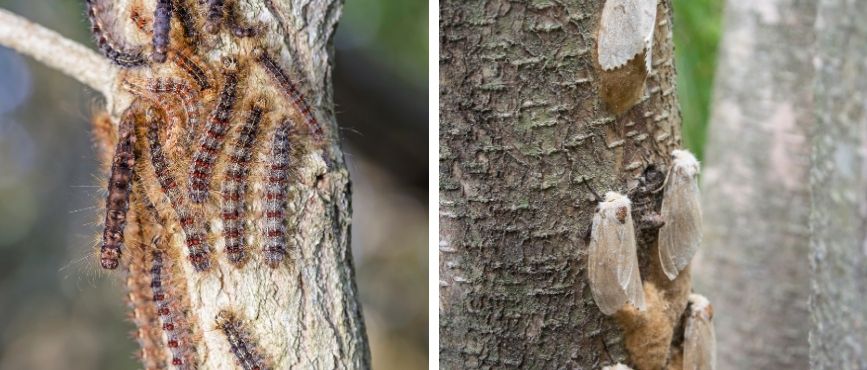
Gypsy Moth
Gypsy moths are destructive pests. They get their name from their ability to travel by attaching to various objects. They appear in late July or August. Males are greyish brown and can fly and survive about one week, mating with several different females. Females are larger and whitish with darker zigzag marks. The female cannot fly and dies shortly after laying her eggs.
Gypsy moth caterpillars (larvae) change looks as they grow. Young caterpillars are black or brown and about .6 cm (.24 inches) in length. As they grow, bumps develop along their backs with coarse black hairs. The caterpillar is easily recognizable in the later part of this stage: charcoal grey with a double row of five blue and six red dots on its back. Feeding ends by early July, and mature caterpillars can be as long as 6.35 cm (2.5 inches).
Should I be concerned? |
|
Gypsy moths are a concern because the larvae feed voraciously, mostly on the leaves of deciduous (leafy) trees, but also on some conifers (evergreens). During the larval stage, a single gypsy moth caterpillar can eat an average of one square metre of leaves. Leaves play a major role in food production for trees, converting light into food by photosynthesis. Reducing the leaf surface available to capture sunlight causes a loss in food production. Deciduous trees can sometimes produce a second crop of leaves, but after repeated defoliation, trees may die or become so weakened that they are vulnerable to secondary infestations. Evergreens may die after only one defoliation. The gypsy moth has been found on approximately 500 species of trees. They prefer broad-leaved trees, mainly red and white oak, poplar, and white birch. The destruction of oaks affects forest wildlife, especially deer that depend on oak acorns for part of their diet. The acorns provide nutrition needed to survive harsh winter conditions. The discovery of the Asian gypsy moth strain in Canada has raised new concerns. The Asian gypsy moth prefers coniferous trees, is better adapted to colder climates, and the female is able to fly. These traits make the Asian gypsy moth a serious threat to Canadian forests. |
How do I know if I have a problem? |
|
The gypsy moth hibernates in egg masses that are covered with tan or buff-coloured hairs, and may be found on tree trunks or bark, outdoor furniture, or the sides of buildings. The egg masses are about the size of a loonie, and may contain from 100 to 1,000 eggs. You can tell how bad the infestation is by the size of the egg mass. When populations are on the decline, egg masses tend to be smaller, about the size of a dime. Larger egg masses are a sign of stable or growing populations. The eggs hatch into caterpillars when tree buds begin to open. This stage, lasting up to seven weeks, is when the insect feeds, so it is important to control gypsy moth infestations early in the growing season. |
How can I get rid of gypsy moths? |
Egg massesGypsy moths spread easily, as the young larvae can be carried by wind currents for a distance of up to one kilometre. More commonly, however, they hitch a ride (mainly egg masses) on objects like vehicles, tents, trailers, and lawn chairs to infest new areas. Vacationers, especially campers, should be aware of this and should check their equipment before moving on. It is important to be thorough when looking for egg masses as they can be difficult to locate. Common hiding places include:
When an egg mass is found, it should be scraped off with a knife and dropped into a bucket filled with hot water and household bleach or ammonia. Remove picnic tables, swing sets, and lawn furniture from around the bases of trees, because these objects provide the insects with protection from the heat of the sun. CaterpillarsCaterpillars and pupae can be handpicked and crushed. The long hairs of the caterpillar can cause skin irritation or allergic reactions in some people. To be safe, wear gloves when handling them. Caterpillars can be successfully trapped. To make a trap, wrap a 45-cm (roughly 17-inch) wide strip of burlap around the tree trunk at chest height. Tie a string around the centre of the burlap and fold the upper portion down to form a skirt, with the string acting as a belt. The caterpillars will crawl under the burlap to escape the sun and become trapped. Later in the day, lift the burlap. Pick off the caterpillars and dispose of them. Contact a professionalConsult an arborist for treatment options or contact your local garden supply store for the availability of materials. |
Additional resources |
Contact Us



 Subscribe to this Page
Subscribe to this Page